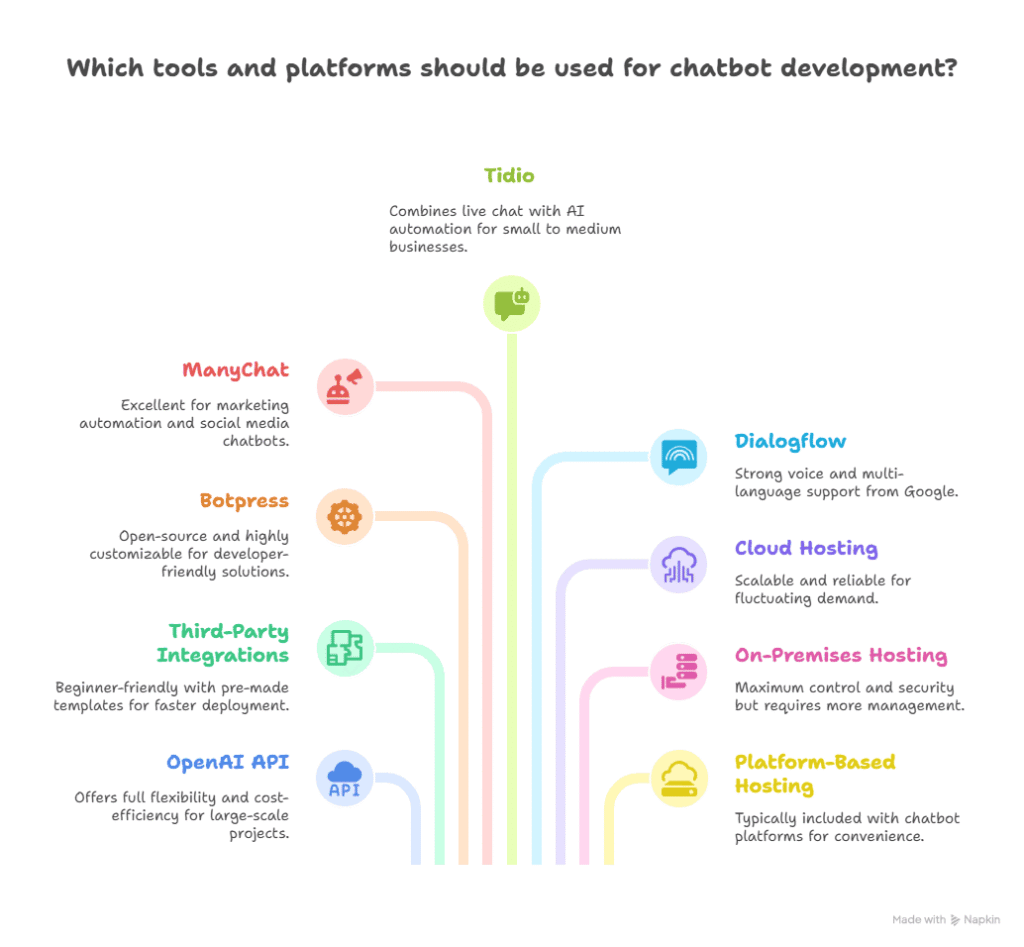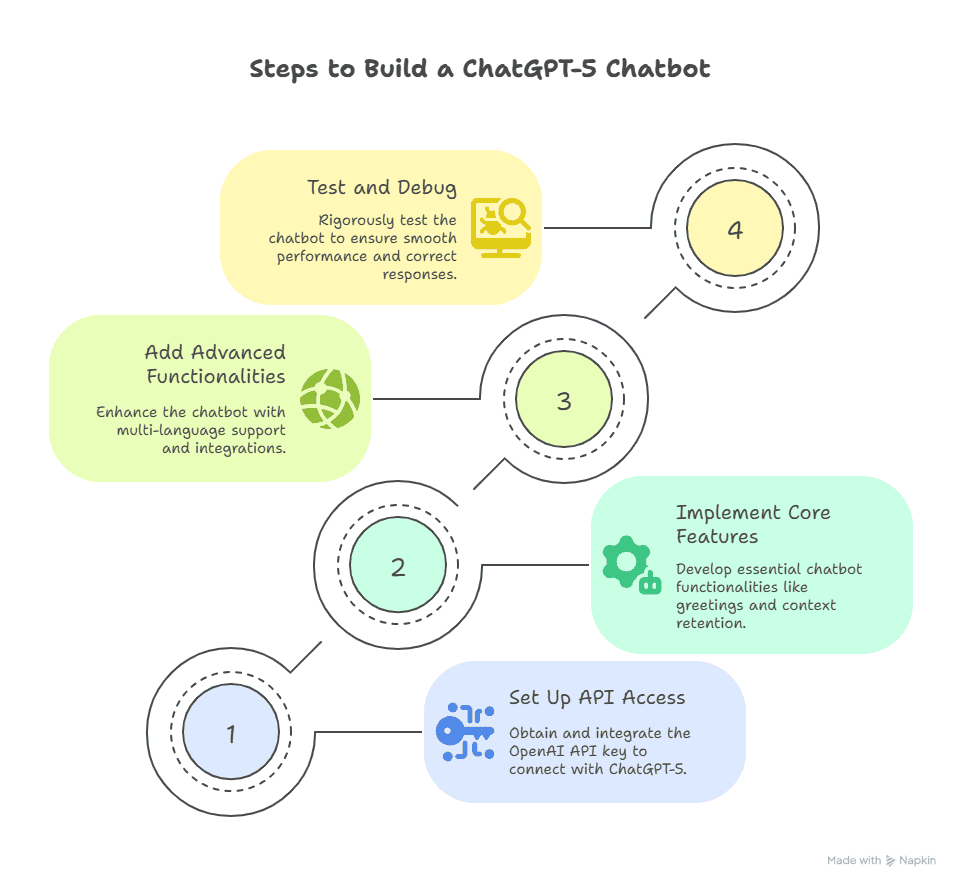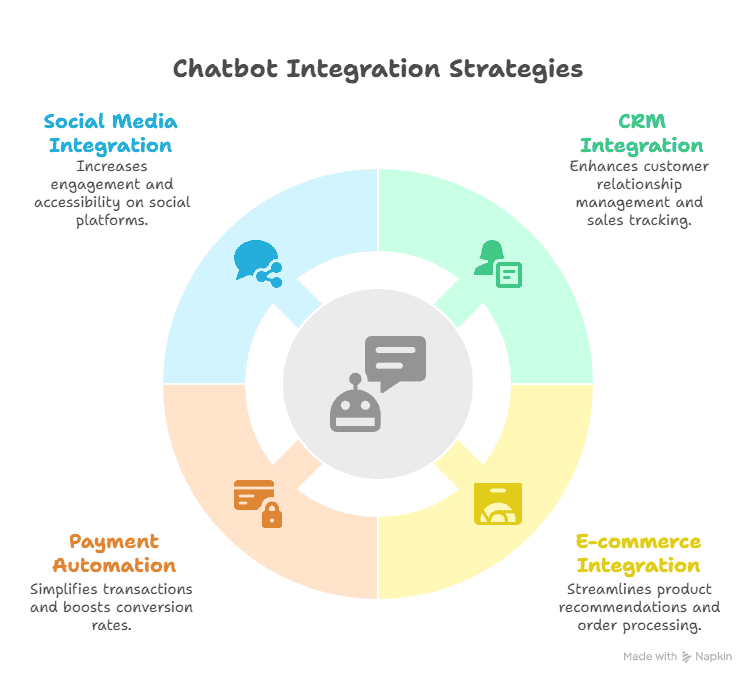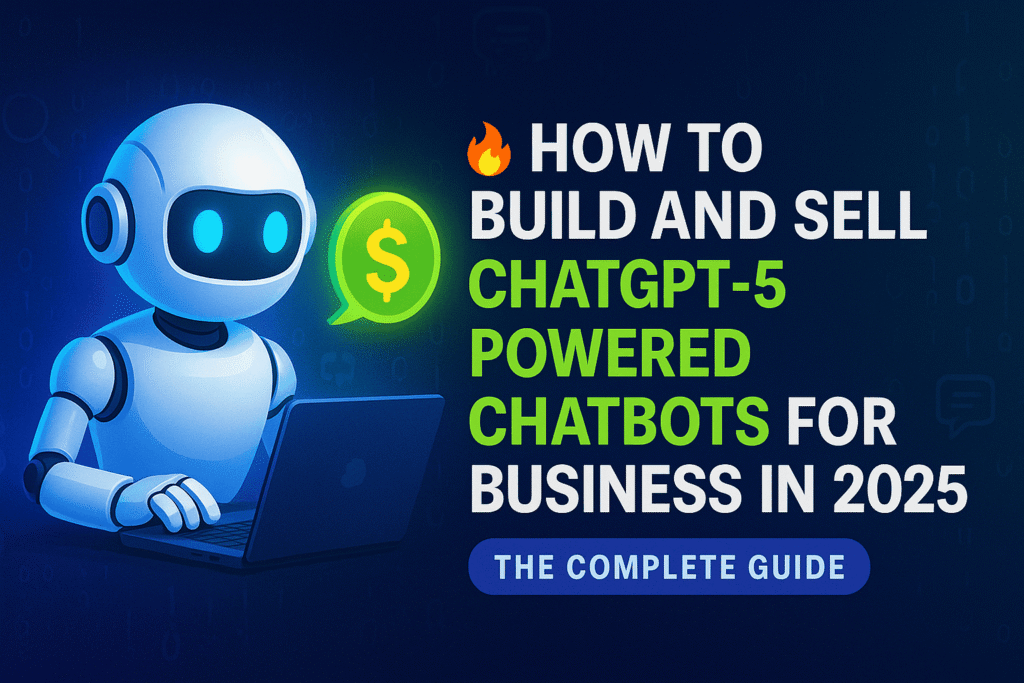Table of Contents
Introduction
The way businesses connect with customers is changing at lightning speed. Gone are the days when customers were willing to wait hours—or even minutes—for a response. Today, instant, personalized, and intelligent interactions are the gold standard, and ChatGPT-5 is at the forefront of this transformation. By combining advanced natural language understanding with business-specific customization, ChatGPT-5 chatbots are no longer just “support bots” — they’re sales assistants, problem solvers, and even brand ambassadors.
In this guide, we’ll explore exactly how you can build and sell ChatGPT-5 powered chatbots for businesses, from understanding the technology to identifying profitable opportunities, planning your project, and making it a success. Whether you’re a tech enthusiast, entrepreneur, or freelancer looking to expand your skills, you’re about to discover the immense potential of this growing industry.
1.1 Why ChatGPT-5 Chatbots Are a Game-Changer for Businesses
ChatGPT-5 represents a leap forward in conversational AI. Unlike earlier models, it understands context far more accurately, adapts its tone to match the brand voice, and learns from past interactions to continually improve. This means businesses can offer round-the-clock customer engagement without the robotic, scripted feel of traditional chatbots.
For companies, this translates to increased customer satisfaction, faster problem resolution, and ultimately higher revenue. It’s not just about replacing human agents—it’s about enhancing their capabilities so they can focus on complex tasks while AI handles the repetitive ones. The result? Lower costs, higher productivity, and a customer experience that feels genuinely human.
1.2 The Rise of AI-Powered Customer Interaction
Over the past few years, AI-driven customer engagement has shifted from a novelty to a necessity. Consumers expect instant answers on websites, social media, and messaging apps—and they expect those answers to be accurate and personalized.
Brands that fail to meet these expectations risk losing customers to competitors who can deliver fast, AI-powered responses. ChatGPT-5 takes this to the next level by enabling more natural, nuanced conversations that go beyond scripted responses. It can handle complex inquiries, recommend products, troubleshoot problems, and even upsell—all without human intervention.
1.3 Who This Guide Is For
This guide is for:
- Entrepreneurs who want to launch a chatbot development business.
- Freelancers seeking to expand their skillset with high-demand AI services.
- Small business owners looking to integrate AI chatbots into their operations.
- Developers and tech enthusiasts who want to understand the practical, commercial side of AI-powered bots.
If you’re ready to tap into one of the fastest-growing tech markets, you’re in the right place.
2. Understanding ChatGPT-5 Technology
2.1 What Is ChatGPT-5 and How It Works
ChatGPT-5 is the latest iteration of OpenAI’s conversational AI, designed to process and generate human-like text based on the context of a conversation. It uses deep learning models trained on massive datasets, enabling it to understand nuances, intent, and emotional tone.
When integrated into a chatbot, ChatGPT-5 interacts with users by interpreting their questions, determining the best possible response, and delivering it instantly. Its advanced reasoning abilities allow it to handle multi-step conversations, remember user preferences, and provide more personalized interactions over time.
2.2 Key Advancements Over Previous Versions
Compared to ChatGPT-4 and earlier models, ChatGPT-5 offers:
- Enhanced contextual memory – It can remember details across longer conversations.
- Improved accuracy – Fewer irrelevant or incorrect responses.
- Dynamic tone adaptation – It can shift its language style to match a brand or audience.
- Better multilingual capabilities – More accurate translations and support for diverse languages.
- Greater efficiency – Faster response times and reduced processing errors.
These upgrades make ChatGPT-5 not only smarter but also more reliable in business-critical scenarios.
2.3 Strengths and Limitations in a Business Context
Strengths:
- Operates 24/7 without breaks.
- Handles high volumes of inquiries simultaneously.
- Consistent and on-brand communication.
- Scalable for businesses of all sizes.
Limitations:
- Requires careful setup to avoid misinformation.
- May still produce occasional errors in highly specialized topics.
- Needs integration with other systems (CRM, payment gateways) for maximum utility.
Understanding both sides ensures realistic expectations when deploying ChatGPT-5 chatbots for clients.
3. Identifying Business Opportunities for Chatbots
3.1 Industries That Benefit Most from AI Chatbots
While any business can leverage chatbots, some industries see exceptional returns:
- E-commerce – Instant product recommendations, upselling, and 24/7 order tracking.
- Hospitality – Automated booking, guest support, and personalized travel suggestions.
- Healthcare – Appointment scheduling, patient FAQs, and follow-up reminders.
- Real estate – Lead qualification, property recommendations, and scheduling viewings.
- Financial services – Account support, loan inquiries, and fraud alerts.
3.2 Common Use Cases: Customer Service, Sales, Lead Generation
- Customer Service: Answer FAQs, troubleshoot issues, and provide self-service solutions.
- Sales: Guide customers through purchase decisions, offer discounts, and upsell.
- Lead Generation: Capture visitor information, pre-qualify leads, and hand them over to sales teams.
By tailoring the chatbot’s purpose to a specific business need, you increase its perceived value and ROI.
3.3 Analyzing Market Demand and Trends
The AI chatbot market is expected to grow exponentially in the next five years, with more businesses investing in automation to improve efficiency. Key trends include:
- Increasing demand for multilingual bots to serve global customers.
- AI integration with social commerce platforms.
- The shift toward hyper-personalized customer experiences.
Researching these trends helps you position your chatbot offering for long-term profitability.
4. Planning Your Chatbot Project
4.1 Defining the Business Problem Your Chatbot Will Solve
Before you write a single line of code, identify the core problem the chatbot will address. Is it to reduce support costs? Increase sales conversions? Provide faster answers to common questions?
A clearly defined purpose ensures your chatbot’s design and functionality directly align with the client’s goals.
4.2 Setting Measurable Goals and KPIs
Set specific metrics to track your chatbot’s performance, such as:
- Average response time.
- Customer satisfaction score.
- Lead conversion rate.
- Reduction in support tickets.
Measurable KPIs give you tangible proof of value for your clients.
4.3 Researching Your Target Audience’s Needs
Understanding the end-user is just as important as understanding the technology. Conduct surveys, analyze customer support data, and review competitor chatbots to identify gaps.
A well-researched chatbot speaks the customer’s language—literally and figuratively—making it more engaging and effective.
5. Choosing the Right Tools and Platforms

5.1 OpenAI API vs. Third-Party Integrations
When building a ChatGPT-5 powered chatbot, you’ll first need to decide whether to work directly with the OpenAI API or use third-party integrations.
- OpenAI API: Offers full flexibility and direct access to the ChatGPT-5 model. This is perfect if you have development skills or a team who can customize every detail. It’s also the most cost-efficient for large-scale projects.
- Third-Party Integrations: Platforms like ManyChat, Tidio, or Botpress offer drag-and-drop builders and pre-made templates. They’re beginner-friendly but may limit advanced customization.
If your goal is a fully tailored solution for a specific business, the OpenAI API is often best. For faster deployment with less coding, third-party platforms can be a great starting point.
5.2 Comparing Popular Chatbot Development Platforms
Some of the most popular platforms to consider include:
- Botpress – Open-source, developer-friendly, and highly customizable.
- ManyChat – Excellent for marketing automation and social media chatbots.
- Tidio – Combines live chat with AI automation for small to medium businesses.
- Dialogflow – Google’s NLP platform with strong voice and multi-language support.
Each has strengths, so choose based on your client’s needs, technical skills, and budget.
5.3 Selecting Hosting and Deployment Options
After building your chatbot, you’ll need to decide where and how it will be hosted:
- Cloud Hosting (AWS, Google Cloud, Azure): Scalable, reliable, and great for businesses with fluctuating demand.
- On-Premises Hosting: Offers maximum control and security but requires more technical management.
- Platform-Based Hosting: If using a chatbot platform, hosting is typically included.
Your choice should align with performance requirements, data security policies, and long-term maintenance plans.
6. Designing Your Chatbot
6.1 Mapping Out User Journeys
Before writing a single response, define the paths a user might take. This includes entry points (website, app, social media), common questions, decision-making steps, and possible exit points. A well-mapped user journey ensures no interaction feels like a dead end.
6.2 Crafting Conversational Flows
Your chatbot’s flow should feel natural and logical. Use branching paths for different user intents and create fallback responses to keep conversations moving. Keep interactions short, clear, and helpful, avoiding overwhelming the user with long text blocks.
6.3 Creating a Brand-Consistent Personality and Tone
Your chatbot should sound like an extension of the business. A playful e-commerce brand might use humor, while a law firm bot should maintain a professional and concise tone. Consistency builds trust and strengthens the brand identity.
6.4 Handling Complex Queries and Escalations
No matter how smart your chatbot is, some issues will require human help. Design clear escalation paths—such as connecting to a live agent or offering a callback. This ensures customers never feel stuck.
7. Building a ChatGPT-5 Powered Chatbot

7.1 Setting Up API Access
To start, sign up for an OpenAI account, generate your API key, and integrate it with your chatbot framework. This connection enables your bot to process user queries via ChatGPT-5.
7.2 Implementing Core Features
Essential features include:
- Greeting messages and welcome prompts.
- AI-driven responses to FAQs.
- Context retention for ongoing conversations.
- Error handling and polite recovery messages.
7.3 Adding Advanced Functionalities (Multi-Language, Integrations)
For a competitive edge, consider:
- Multi-Language Support – Reach global customers in their native tongue.
- Integrations – Link with CRMs, booking systems, or e-commerce platforms for richer functionality.
7.4 Testing and Debugging the Chatbot
Before launch, rigorously test your bot with real-world queries. Use beta testers, simulate high traffic, and watch for performance bottlenecks or incorrect responses. Fix issues before going live to ensure a smooth experience.
8. Integrating Your Chatbot into Business Systems

8.1 CRM Integration
Integrating with tools like HubSpot or Salesforce allows your chatbot to store customer interactions, enabling personalized follow-ups and improved sales tracking.
8.2 E-commerce Platform Integration
Connect your chatbot with Shopify, WooCommerce, or Magento so it can check inventory, recommend products, and even process orders directly within the conversation.
8.3 Payment Processing and Automation
Integrating payment gateways like Stripe or PayPal enables customers to complete purchases without leaving the chat. Combined with automation, this can significantly boost conversion rates.
8.4 Social Media and Messaging Apps Integration
Deploy your chatbot on Facebook Messenger, WhatsApp, Instagram, or Telegram to meet customers where they already spend time. This boosts engagement and accessibility.
9. Ensuring Compliance and Security
9.1 Data Privacy Laws (GDPR, CCPA, etc.)
Ensure your chatbot complies with relevant privacy laws by gaining consent before collecting data and giving users the ability to delete their information.
9.2 Secure API Authentication
Protect your chatbot from unauthorized access by using encrypted API keys, HTTPS connections, and regular security audits.
9.3 Ethical AI Guidelines
Implement guardrails to prevent inappropriate, biased, or misleading responses. Regularly monitor conversations and refine training data to maintain ethical standards.
9.4 Preventing Misuse and Bias
Bias can creep into AI responses if not managed. Use diverse datasets, apply fairness testing, and establish filters to prevent harmful outputs.
10. Training and Fine-Tuning the Chatbot
10.1 Using Business-Specific Data
A generic chatbot can answer basic questions, but a truly effective one uses business-specific data to provide accurate, tailored responses. This can include product catalogs, company policies, FAQs, and historical customer interactions. Feeding ChatGPT-5 with such data ensures the chatbot reflects the brand’s unique knowledge base, delivering answers that feel personal and relevant.
10.2 Leveraging Feedback Loops
No chatbot is perfect from day one. Implement feedback mechanisms—like thumbs up/down buttons or quick surveys after interactions—to learn what’s working and what isn’t. This real-time feedback helps refine responses, identify gaps, and improve customer satisfaction over time.
10.3 Continuous Improvement Strategies
Keep your chatbot fresh by:
- Regularly updating its training data.
- Monitoring conversation logs for patterns and missed opportunities.
- Adapting to seasonal changes, product launches, and evolving customer needs.
The more your chatbot learns, the more valuable it becomes to the business.
11. Monetizing ChatGPT-5 Chatbots
11.1 Selling Custom Chatbot Solutions to Businesses
Many companies are willing to pay for a chatbot tailored to their exact needs. Custom projects often command higher prices because they require unique features, integrations, and branding.
11.2 Offering Subscription-Based Chatbot Services
Rather than charging a one-time fee, offer ongoing chatbot hosting, updates, and maintenance for a monthly subscription. This provides stable, recurring income and ensures long-term client relationships.
11.3 White-Labeling Chatbot Products
White-label solutions allow agencies and resellers to rebrand your chatbot as their own. This expands your reach without requiring direct sales to every end customer.
11.4 Partnering with Agencies and Resellers
Collaborate with digital marketing agencies, software firms, or IT consultants who can sell your chatbot solutions to their existing client base. These partnerships can significantly shorten your sales cycle.
12. Marketing Your Chatbot Services
12.1 Building a Strong Online Presence
Create a professional website showcasing your chatbot solutions, features, and pricing. Include a blog, portfolio, and contact options to convert visitors into leads.
12.2 Leveraging Content Marketing and SEO
Publish articles, guides, and case studies optimized for keywords like “AI chatbot for business” or “ChatGPT-5 customer service bot.” Organic traffic can bring you a steady stream of potential clients.
12.3 Social Media Marketing Strategies
Showcase chatbot demos on LinkedIn, Instagram, and TikTok. Use short videos, carousel posts, and behind-the-scenes content to grab attention and build credibility.
12.4 Using Case Studies and Testimonials to Build Trust
Before-and-after stories with measurable results are powerful sales tools. Pair them with client testimonials to prove your solutions deliver real value.
13. Pricing Strategies
13.1 Cost-Based Pricing
Calculate your expenses (development time, hosting, integrations) and add a profit margin. This method is simple but may undervalue high-impact projects.
13.2 Value-Based Pricing
Price according to the value your chatbot provides to the business—such as increased sales or reduced support costs. This often leads to higher profits than cost-based pricing.
13.3 Tiered Packages and Add-Ons
Offer multiple pricing tiers (basic, professional, enterprise) to appeal to different budgets. Include optional add-ons like analytics dashboards or extra integrations.
13.4 Offering Free Trials and Demos
A hands-on demo lets potential clients experience the chatbot’s value before committing. This reduces purchase hesitation and builds confidence.
14. Selling to Businesses
14.1 Identifying Decision-Makers
In most companies, purchasing decisions for tech solutions are made by managers, directors, or C-suite executives. Target your outreach to these individuals for the best results.
14.2 Crafting an Irresistible Sales Pitch
Highlight the problems your chatbot solves, the ROI it delivers, and the ease of implementation. Keep your pitch concise and focused on business outcomes.
14.3 Overcoming Common Objections
Clients may worry about cost, complexity, or reliability. Address these concerns with real-world examples, performance data, and strong customer support assurances.
14.4 Negotiating and Closing Deals
Be flexible with pricing structures and payment terms, but stay firm on the value you provide. Follow up promptly and close deals while interest is high.
15. Post-Sale Support and Maintenance
15.1 Providing Technical Support
Offer responsive support channels (email, chat, phone) to address client issues quickly. A well-supported chatbot keeps customers happy and loyal.
15.2 Updating Chatbots with New Features
Regularly add features to keep your chatbot competitive—like better AI models, new integrations, or voice capabilities.
15.3 Offering Performance Reports to Clients
Provide monthly or quarterly reports showing metrics like customer satisfaction, response times, and lead conversions. These reports prove your ongoing value and justify renewals.
16. Scaling Your Chatbot Business
16.1 Automating Your Sales Process
As demand for your chatbot services grows, you can’t personally handle every sales inquiry. Automate lead collection with landing pages, chat widgets, and email sequences. Use CRM tools to nurture leads and set up automated demos that showcase your chatbot in action—saving you time and keeping your pipeline full.
16.2 Hiring and Outsourcing Development
When projects pile up, bring in help. Hire in-house developers for core projects and outsource smaller tasks to vetted freelancers. This lets you maintain quality while increasing output without burning out.
16.3 Expanding into New Industries and Markets
Once you’ve established a foothold in one industry, explore others where chatbots can provide value. For example, if you started with e-commerce, you could expand into healthcare, real estate, or education—adapting your solutions for each sector’s needs.
17. Case Studies
17.1 Small Business Success Story
A boutique online store implemented a ChatGPT-5 chatbot for customer support and saw a 40% decrease in email inquiries within two months. This freed up the owner’s time to focus on growth and led to a 15% boost in sales through personalized upselling.
17.2 Enterprise-Level Implementation
A multinational tech company integrated a ChatGPT-5 chatbot into its customer service operations across 12 languages. The result: reduced support costs by $1.2M annually, improved customer satisfaction scores by 22%, and provided 24/7 service without increasing staffing.
17.3 Niche Market Application
A local fitness coach used a chatbot to answer client FAQs, send workout reminders, and upsell nutrition plans. Within six months, the chatbot accounted for 25% of all new bookings—with minimal ongoing management.
18. Common Mistakes to Avoid
18.1 Overcomplicating the Chatbot
Adding too many features can confuse users. Focus on solving the core problem first before introducing advanced functions.
18.2 Ignoring User Feedback
Customer feedback is gold for improving your chatbot. Ignoring it can lead to repetitive mistakes and frustrated users.
18.3 Neglecting Security and Compliance
Failing to follow data privacy laws or secure your chatbot’s API could lead to legal trouble and damage your reputation.
18.4 Poor Marketing Execution
Even the best chatbot won’t sell itself. A weak marketing strategy can result in wasted potential—invest in consistent promotion and lead generation.
19. Future of ChatGPT-5 Chatbots
19.1 Emerging AI Trends
Expect increased personalization, emotional intelligence in conversations, and AI models that can process multimedia inputs like images and voice.
19.2 Integration with Other Emerging Technologies
Future chatbots may work seamlessly with augmented reality, IoT devices, and blockchain for secure transactions—opening new business possibilities.
19.3 Predictions for the Next 5 Years
Within five years, AI-powered chatbots will likely become standard in most customer-facing roles, offering hyper-personalized, real-time support that rivals human agents in speed and accuracy.
20. Conclusion
20.1 Key Takeaways
- ChatGPT-5 chatbots can revolutionize customer interaction.
- Success depends on planning, customization, and marketing.
- Scalability comes from automation, hiring, and entering new markets.
20.2 Encouragement to Take Action
The AI wave is here, and businesses that adopt early will reap the rewards. Whether you’re a solo entrepreneur or part of a team, now is the time to build, sell, and scale ChatGPT-5 powered chatbot solutions.
20.3 Resources for Continued Learning
- OpenAI API Documentation
- AI Business Trends Blogs
- Online chatbot development courses (Udemy, Coursera)
21. FAQs
Q1: How much does it cost to build a ChatGPT-5 chatbot?
Costs vary depending on complexity, but a basic chatbot could start at $500–$2,000, while enterprise-grade solutions can exceed $10,000.
Q2: Can ChatGPT-5 chatbots replace human customer service agents?
Not entirely. They can handle repetitive queries and free up human agents for complex or emotional issues.
Q3: How can I make my chatbot multilingual?
Use ChatGPT-5’s multilingual capabilities or integrate with translation APIs for languages not natively supported.
Q4: What industries get the most ROI from chatbots?
E-commerce, tech support, healthcare, finance, and real estate often see the highest returns due to high customer interaction volumes.
Q5: How do I protect my chatbot from hacking attempts?
Implement secure API authentication, monitor traffic for anomalies, and follow best practices for data encryption and privacy compliance.

